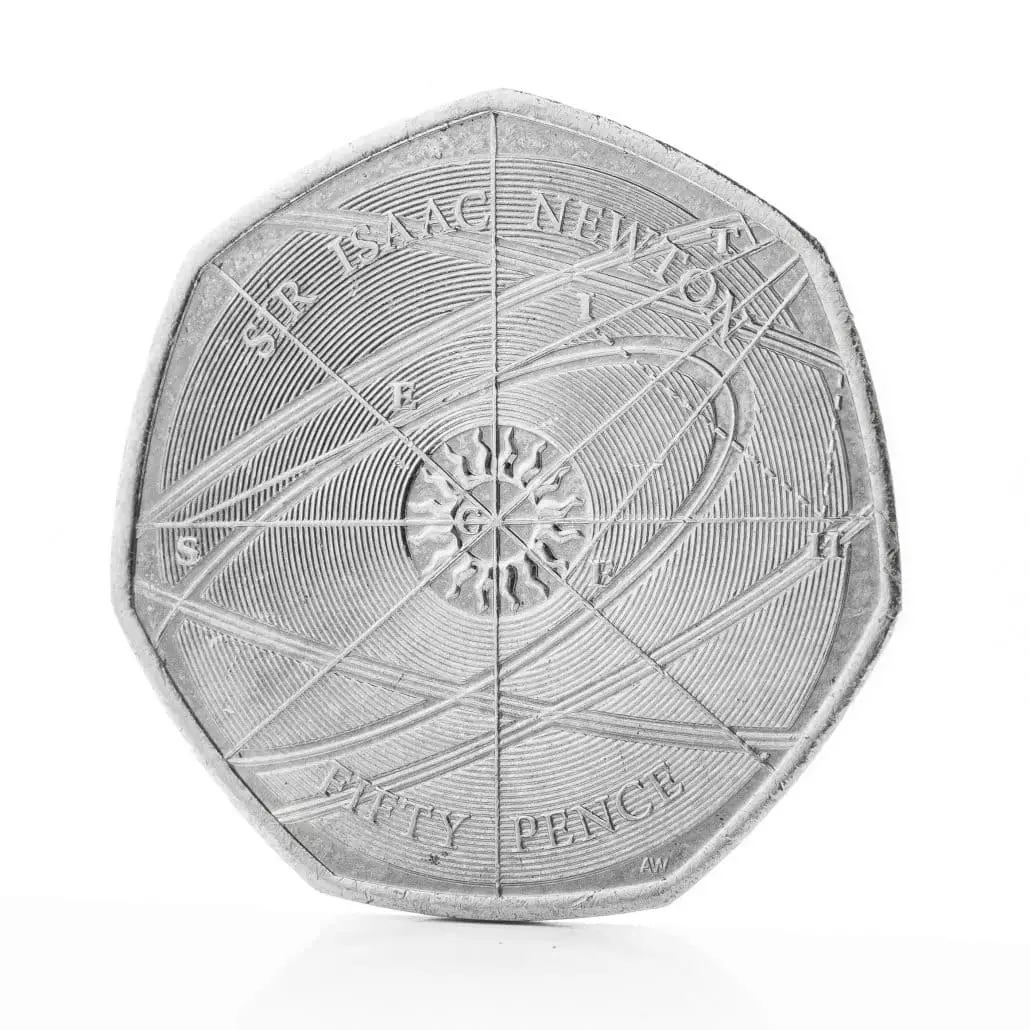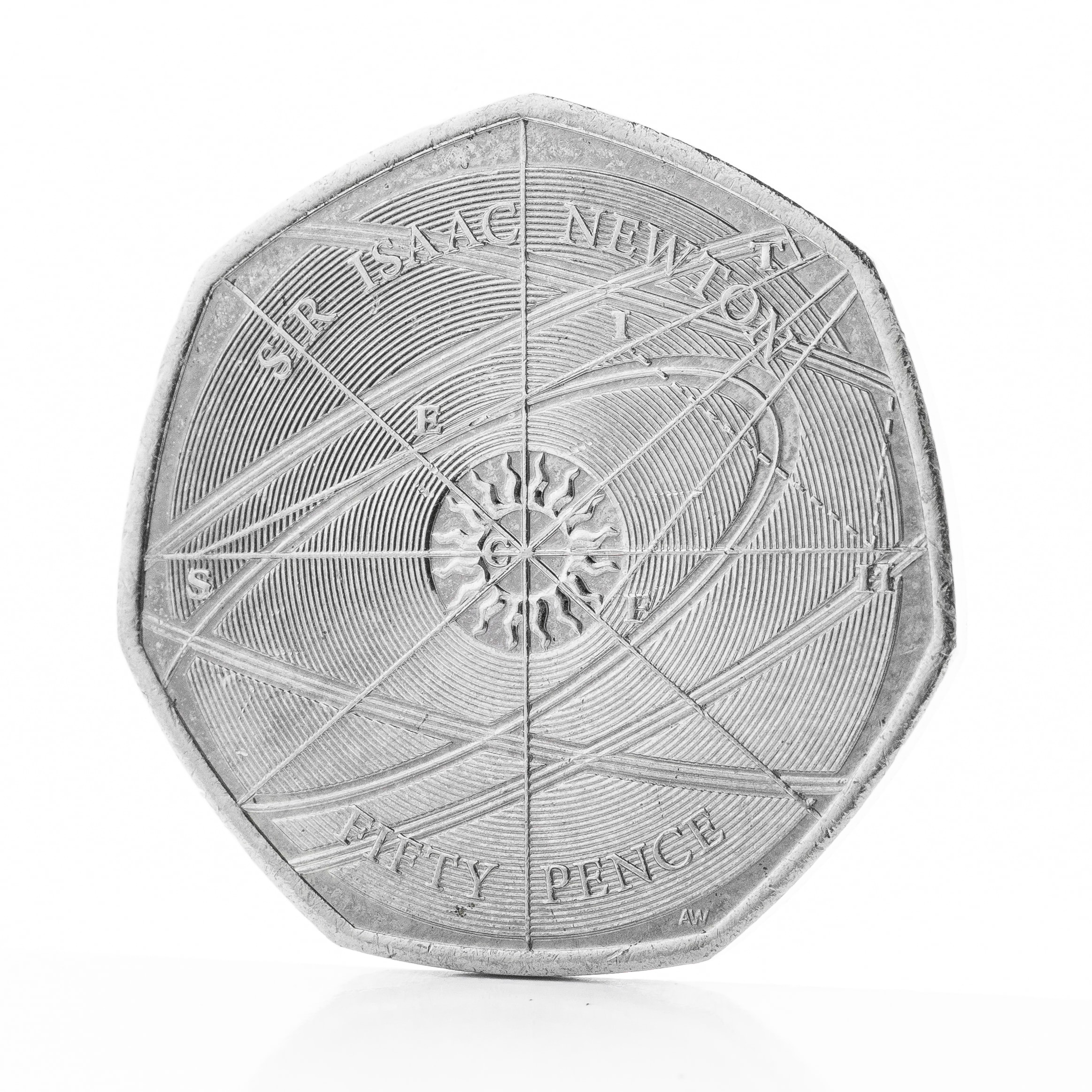The Isaac Newton 50p has an iconic design and has been in circulation since 2017 making it a relatively new coin; but how much is it worth today?
If you come across an Isaac Newton 50p you’ll be happy to know that they are worth around £2.60 according to the latest values in 2022 in circulated condition. If you have a proof version, they can be worth much more – with gold proof versions selling for around £1,000.
If you want to learn more about the coin, including about 2018 version that is much rarer, then jump into the rest of this article.
Is the Isaac Newton 50p Coin Rare?
When discussing how rare a coin is, it is crucial to look at the mintage figures first to see how many were introduced into circulation.
The Isaac Newton 50p had a mintage of 1,801,500, which is on the lower end for 50p coins. To put this into context, some other 50p coins minted in the same year include the Jeremy Fisher 50p which had a mintage of 9,900,000 and the Tom Kitten 50p with a mintage of 9,500,000.
This is reflected in the average sale price on eBay fluctuating around £2.50 in recent years – around 5 times the face value of the coin.
Alongside the circulating version, there were also several proof versions issued by the Royal Mint for which the mintage figures can be seen below.
| Version | Mintage | Estimated Value |
| Circulated | 1,801,500 | £2.60 |
| Brilliant Uncirculated (Single) | N/A | £10 |
| Brilliant Uncirculated (2017 Annual Set) | N/A | £55 |
| Silver Proof | 4,000 | £50 |
| Silver Proof Piedfort | 3,000 | £100 |
| Gold Proof | 500 | £980 |
2018 Isaac Newton 50p?
In 2018 the Royal Mint offered an experience where you could strike your own Isaac Newton 50p in brilliant uncirculated quality.
The date on the obverse of the coin is 2018, and the mintage for these limited edition versions is unknown to this day but is estimated to be in the tens of thousands – making the coin incredibly rare.
On eBay, you’re looking at spending £30 to £50 to purchase a 2018 edition, and they have been listed for as much as £100 on online coin dealership websites.
Design And Specification of the Isaac Newton 50p
The reverse features a design by Aaron West to mark the 375th anniversary of the famous scientist’s birthday. The image represents one of Newton’s theories revealing the sun at the centre and three ellipses to represent the orbits of different planets.

The image is a diagram of the Solar system and is based on elements of Proposition 11 in Book One of Newton’s Principia Mathematica. The sun is the common focal point and is based on the concept that all planets rotate around the sun and not the earth as previously thought.
The letters S E I T C F H are dispersed throughout the design to represent mathematical notations that Newton had included in his original diagrams. The image places the sun in the centre encircled by rings that get larger in circumference as they radiate out from the sun.
The words SIR ISAAC NEWTON are curved and centred toward the top, and the words FIFTY PENCE are curved and centred at the bottom. The initials AW are seen on the bottom right to indicate the designer Aaron West.
The Obverse design is that of Queen Elizabeth II designed by Jody Clark.
In this version, her mature head is crowned with her coronation crown and facing right. The crown is also referred to as the Royal Diamond Diadem crown. Surrounding her head are the words 50 PENCE * 2017 * ELIZABETH II * D * G * REG * F * D * which means Elizabeth The Second, by the Grace of God, Queen, Defender of the Faith. The designer’s initials, JC, are seen just below the Queen’s neckline.
The specifications of the coin can be seen below:
| Weight (g) | 8.00 |
| Diameter (mm) | 27.3 |
| Thickness (mm) | 1.78 |
| Alloy | Cupro-nickel |
| Edge | Plain with no inscription |
Newton’s Mint Connection
Sir Isaac Newton was a very significant Scientific Revolution figure of the 17th century. His theories and legacy shaped our understanding of mathematics and physics.
This scientific icon also authored one of the most influential books on physics ever written. He combined complicated mathematic formulas with his belief in God to introduce important laws of the universe.
He helped to discover laws of gravity and motion, invented calculus, and even brought integrity to The Royal Mint; a fun fact that many coin enthusiasts might be unaware of.
Sir Isaac Newton also held the role of Master of the Mint as of 1699. When he came to the Royal Mint, Britain’s finances were nearing crisis with as many as 10% of circulating coins believed to be counterfeit and forged. He began to root out and prosecute counterfeiters.
He also improved the way coin quality is checked, known as assaying techniques, and refined measures and weights to new standards.
Part of his duties included overseeing the new coinage for the accession of Queen Anne and later supervising the process of bringing Scottish coinage into line with English coinage after the Union of England and Scotland in 1707. Because of his vision, Royal Mint coins are still unrivalled in accuracy and purity.
